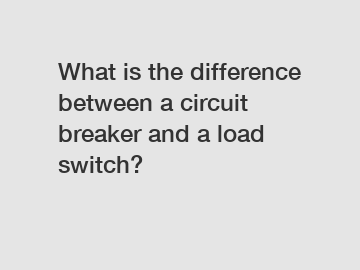What is the difference between a circuit breaker and a load switch?
Electrical systems are a labyrinthine wonder, intertwining various components to ensure smooth and safe operations. Among these components, circuit breakers and load switches play crucial roles in controlling and protecting power distribution. While their purpose may seem similar at first glance, there are essential differences between the two. In this blog post, we will dive deep into the intricacies of circuit breakers and load switches, unraveling their distinctions and shedding light on their functioning.
Circuit Breakers: The Guardians of Electrical Safety.
Circuit breakers form the backbone of electrical protection systems. Acting as automatic switches, they function as safety devices to prevent damage from excessive currents, short circuits, and overloads. Circuit breakers are typically placed within distribution boards or switchgear panels and are responsible for stopping the flow of current in case of an anomaly.

When a circuit experiences a surge in current, due to either a short circuit or an overload, the circuit breaker swiftly interrupts the power flow, preventing damage to the electrical system. This protection mechanism reduces the risk of fire hazards, damage to expensive equipment, and electrical shock.
Circuit breakers are characterized by their highly efficient tripping mechanism, ensuring rapid interruption of the circuit whenever a fault occurs. They consist of a thermal element that responds to overcurrent levels and a magnetic element that acts upon sudden and short surges. Circuit breakers are often categorized based on their tripping mechanisms, current ratings, and voltage levels, catering to various electrical setups and applications.
Load Switches: Controlling Power with Finesse.
Load switches, on the other hand, are designed to control the flow of power to specific circuits or devices. Their primary purpose is to either connect or disconnect the load from the power supply. Unlike circuit breakers, load switches are manually operated or controlled through an external signal, allowing users to regulate power to specific areas or equipment as needed.
Load switches are commonly employed in scenarios where power management and selective control are crucial. For instance, in large industrial setups or smart homes, load switches are used to control lighting, appliances, or HVAC systems effectively. By functioning as discrete switches, load switches provide finer control over individual loads without affecting the entire circuit.
It's important to note that load switches are not designed to offer the high level of protection that circuit breakers provide against faults or abnormal conditions. Their aim is focused more on precise power management rather than safety measures.
Understanding the Key Differences.
While both circuit breakers and load switches contribute to electrical control and safety, it's essential to distinguish their unique characteristics to determine which component suits a specific purpose. Here are some crucial differences:
1. Functionality: Circuit breakers ensure safety by breaking the circuit when faults occur, whereas load switches offer precise control over power distribution without protecting against faults.
2. Operating Mechanism: Circuit breakers interrupt the power flow automatically when faults occur, relying on mechanical, thermal, or electromagnetic triggering mechanisms. Load switches, however, are manually operated or controlled via external signals.
3. Built-in Protection: Circuit breakers are equipped with various protective features like overcurrent, short-circuit, and overload protection, ensuring a high level of safety. Load switches, being control devices rather than protection devices, do not typically offer these protective features.
Conclusion:
In summary, circuit breakers and load switches are distinct electrical components with specific roles within power distribution systems. While circuit breakers prioritize safety through automatic interruption during faults, load switches focus on versatile power control. Understanding these differences is crucial in determining the optimal use of these components for diverse applications, ensuring the efficiency, safety, and smooth functioning of electrical systems.
If you are looking for more details, kindly visit reliable outdoor prefabricated substation, outdoor switchgear, voltage xl.

Comments